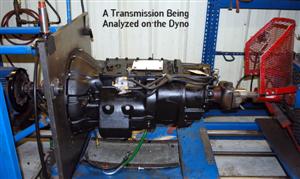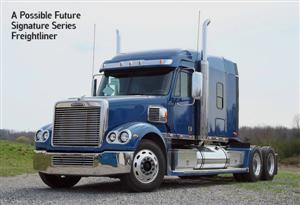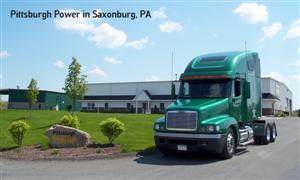June 2009 - Performance Zone
UTILIZING DIRECT DRIVE
By Performance Specialist Bruce C. Mallinson
As a 10-4 Magazine reader, you know from previous articles that we are currently building what we call the “Signature Series” truck. This truck is a combination of features that Kevin Rutherford and I have come up with over the years of our experience in the trucking industry. In this Signature Series truck, both Kevin and I have combined our knowledge and built the ultimate truck for fuel mileage and longevity – something we feel the readers of 10-4 Magazine are particularly interested in.
In last month’s article we talked about building our own custom 2009 Peterbilt 389 glider kits with our engine and choice of transmission out of our shop in Saxonburg, PA. These trucks are custom built to your specifications and you get to pick every option you want. This month we will look at the best transmission and gearing setups for taking advantage of using direct drive.
We always knew that the direct gear was the best gear to be in when pulling a hill, but did you know that it is also the most efficient gear to run in when not pulling a hill? In this case “most efficient” means less power lost to the drivetrain, more power to the drive tires and better fuel mileage. Overdrive gears are where most of these losses in power come from. Instead of power going to the rear wheels, it’s being lost through heat in the transmission.
So, now you’re thinking, “If I drive in direct gear my speed will be in the low 50 mph range – I can’t do that!” Well, if you have 3.36 or 3.55 gears you’re right – you can’t drive in direct gear. However, you can run your truck in direct gear if you install 2.65 (or better yet 2.79) rear gears. With this gearing setup, everybody seems to think they will not be able to start out on a hill, but this is just not true. Many fleets out there are running this gearing setup with 10-speed direct transmissions. I know many of you are thinking you don’t want a 10-speed transmission – you love your 13-speed or 18-speed and that’s okay (I do too). My Kenworth has a single over 18-speed that I would not give up for the world. However, I do run in direct gear when I’m pulling long grades, bucking head or side winds or driving slow.
 If you need the ability to start on steep grades, just make your first and second gears lower. Overdrive is NOT the place to make up for speed, the differential is. The differential gear ratio is what determines the cruising speed of a vehicle, NOT the transmission. The transmission only makes it possible to get to the predetermined cruising speed, it is NOT intended to determine the cruising speed. Now, for those of you who have a double overdrive transmission, did you know in order to run in direct gear you have to drop down two gears? Therefore, a 13-speed double over has to run in 11th gear and an 18-speed has to be in 16th gear to be in direct gear. That is the gear you should be in when pulling mountains. Those of us that are horsepower nuts think it’s manly to say that our truck will pull a certain mountain in the Big Hole! But, as you know, “The Big Hole” was intended for cruising, not pulling – direct gear is for pulling.
If you need the ability to start on steep grades, just make your first and second gears lower. Overdrive is NOT the place to make up for speed, the differential is. The differential gear ratio is what determines the cruising speed of a vehicle, NOT the transmission. The transmission only makes it possible to get to the predetermined cruising speed, it is NOT intended to determine the cruising speed. Now, for those of you who have a double overdrive transmission, did you know in order to run in direct gear you have to drop down two gears? Therefore, a 13-speed double over has to run in 11th gear and an 18-speed has to be in 16th gear to be in direct gear. That is the gear you should be in when pulling mountains. Those of us that are horsepower nuts think it’s manly to say that our truck will pull a certain mountain in the Big Hole! But, as you know, “The Big Hole” was intended for cruising, not pulling – direct gear is for pulling.
Running in the direct gear gives you more power to the rear wheels and improves fuel mileage. The engine will also live longer because it’s not turning the overdrive unit. However, as mentioned before, many of you don’t want to give up your 13 and 18-speed transmissions. So, all you need to do is put a 2.79 gear ratio in the differentials, run the transmission in direct gear, and only use overdrive when you are bobtailing, running empty or just want to speed, which some of us need to do from time to time. Another time when overdrive can be handy is when you are coming down a long grade – up shift the transmission and just let the truck coast down the grade. Any time you are moving forward and your foot is not on the throttle, you are getting “free” mileage.
Think about this: a Cummins M-11 with 450 hp installed in a motor home with an Allison World Transmission locks the torque converter in 2nd gear through 6th gear to eliminate slippage. This is a good thing, however the RV industry decided to go to lower gears in the differentials, and now the World Transmission is a double overdrive which loses 40% of the engine’s power in 6th gear. So, now our M-11 engine with 450 hp can only put 290 horses to the ground in 6th gear. That is a lot of lost power.
Then why the double overdrive you ask? Because back in the early 1990’s, most 13 and 18-speed transmissions were double overdrive, which means they lost more power in high gear than the older 13-speed transmissions we had back in the 1970’s and 1980’s. With an overdrive transmission, the higher the percentage of overdrive ratio becomes, the less power gets to the rear tires and the worse the fuel mileage becomes. So why did Eaton go to a double overdrive setup? Because the engine manufacturers wanted their engines running at 1,300 and 1,400 rpm, so in order to have a reasonable cruising speed and run the engine at lower rpm ranges, they went with a double overdrive transmission. That was the WRONG way to go. The manufacturers should have stayed with the single overdrive transmission and made the difference up in the rear differential ratio.
 We are currently building a Signature Series truck for Vance Vest. When completed, this truck will have a Detroit Locker single drive axle with a gear ratio of 2.79, a tag axle and super single tires. Vance does the same 3,200-mile run every week and is only heavy for 1,100 of those miles. He will run with the tag axle down for those 1,100 miles, but the rest of the time the tag axle will be raised. With super single tires on the trailer, if his trailer has the capability to raise one axle, he will be able to run 2,200 miles per week with just six tires on the ground. As you know (or should know), every time you add a tire to the ground, you’re adding rolling resistance and decreasing your fuel mileage, so the fewer the better.
We are currently building a Signature Series truck for Vance Vest. When completed, this truck will have a Detroit Locker single drive axle with a gear ratio of 2.79, a tag axle and super single tires. Vance does the same 3,200-mile run every week and is only heavy for 1,100 of those miles. He will run with the tag axle down for those 1,100 miles, but the rest of the time the tag axle will be raised. With super single tires on the trailer, if his trailer has the capability to raise one axle, he will be able to run 2,200 miles per week with just six tires on the ground. As you know (or should know), every time you add a tire to the ground, you’re adding rolling resistance and decreasing your fuel mileage, so the fewer the better.
Here is a challenge for you: next month, keep a log of your miles traveled and the weights you were hauling to see if your type of trucking could be accomplished with less tires on the ground. Landstar recently did a study and found that 72% of their miles could be driven on just six tires using super singles. You could save about two miles per gallon just by switching to this setup. Right now, with fuel averaging $2.17 per gallon, this might not mean much to you, but we all know it will eventually hit $4.00 a gallon again (probably sooner than later), so why not be ready?
If you drive 150,000 miles per year and your truck averages six miles per gallon, you will spend $54,250 on fuel. At eight miles per gallon, you will spend $40,687 on fuel, giving you a savings of $13,563 on just the first 150,000 miles driven. Now, at $4.00 per gallon, the savings will be $25,000 per 150,000 miles driven. Do you think that this may be worth thinking about or looking into? Do you really think that a standard semi truck with five axles and eighteen tires on the ground, running in double overdrive, is the most efficient way to move freight? Many of you are already getting seven to eight mpg – just think how much more you could save if you were getting ten mpg. Get out your calculator and do the math, it just might be worth making some changes to your truck!
Radio talk show host Kevin Rutherford (XM 171 and Sirius 137) and I differ on our opinions when it comes to horsepower, however we both agree that a free-running engine, turning only the amount of tires it needs to haul the load onboard, is the truck that will get the best possible fuel mileage. Did you know that for every one mph you slow down you will save 1/10th mpg? And, by all means, you should drive your truck, not set the cruise control and take a nap. Driving with the cruise control set, especially on hilly terrain, can rob half a mile per gallon from your truck’s efficiency.
Bob Eubanks runs a fleet of six trucks out of Akron, Ohio. After reading one of my articles about properly using the cruise control, he went from using it 80% of the time to only 20% of the time. By doing so, he says that he saved half a mile per gallon. Bob’s truck runs on Michelin super single tires and has many of our fuel-saving components, including a ported exhaust manifold, performance mufflers, a new silicone-filled engine damper, a new mercury-filled engine balancer, and a FASS Fuel System. Bob’s W900L Kenworth pulls a van and gets fuel mileage in the seven mpg range. Bob is an extremist when it comes to power – he races a 48-foot Fountain boat that has 2,000 hp and hits a top speed of 120 mph across the ocean. Of course, he runs a Pittsburgh Power performance computer in several of his trucks, and all of his “Bridge” Cats have been “unbridged” by Pittsburgh Power.
If you squeeze the buck and don’t spend any money on your truck for fuel mileage improvements, you just won’t get better fuel mileage. Like I have always said, “If you always do what you’ve always done, you’ll always get what you’ve always got, or less!” Keep that in mind the next time you are pondering whether or not to invest in some fuel-saving components. If you have any questions, feel free to contact me at Pittsburgh Power in Saxonburg, PA at (724) 360-4080 or via e-mail at bruce@pittburghpower.com.
